March 2017
“I was angry with my school because no one at my school was able to identify that I was homeless. I was angry that I went from being an A student, well behaved, but then I was criticized because my behavior started to change. No one took the time to understand why my behavior changed. No one took the time to ask me why there were so many wrinkles in my shirt. But the school was quick to criticize me, they was quick to give me in-house suspension, they was quick to warn to expel me. … If it wasn’t for [a Students in Temporary Housing Content Expert] coming to the school advocating for me, I probably would have been expelled.”
—Graduate, Class of 2010
Executive Summary
In New York City, one out of every eight public school students has been homeless at some point in the past five years. One in four (26%) of these students is in high school. In More Than a Place To Sleep: Understanding the Health and Well-Being of Homeless High School Students, we begin to explore differences in risk behaviors and health outcomes between homeless high school students and their housed classmates. Homeless high school students are struggling to not only find a place to sleep, but to meet their mental, emotional, and physical health needs as they pursue educational goals necessary to break the cycle of poverty and homelessness.
A Heavy Burden
Homeless students face disproportionate burdens across the board—they are more likely to fall behind academically due to school transfers, absenteeism, and other instability factors; they are more likely to be suspended; they are less likely to receive timely identification for special education services; and the list goes on. What this report reveals is that these students face yet another set of obstacles to educational achievement—their health and risk behaviors—that, if unaddressed, will make it harder for them to finish school, follow professional goals, and remain stably housed in their own adult lives.
As New York City works to improve outcomes for homeless students, those efforts must incorporate an understanding of risk behaviors and health outcomes, which have been shown to predict well-being and productivity later in life. This report uses data from the Centers for Disease Control’s 2015 Youth Risk Behavior Survey (YRBS), which for the first time includes survey questions allowing us to distinguish homeless from housed students.
A Promising Approach
One promising approach is ensuring the access of homeless teens to school-based health centers. While homeless students have limited access to these centers, they are more likely than their housed peers to use health services when they are available. Moreover, many shelters could be re-envisioned as Community Residential Resource Centers (CRRCs) where educational resources and support services could be made available to not only homeless students, but all students in the community.
Meeting the needs of homeless high school students is paramount, as risk behaviors and health outcomes impact their futures. These students have unequivocally worse health outcomes than housed teens. They also make up a disproportionately large segment of students facing the most extreme health risks. At only 11% of high school students, homeless students represent a third or more of all students facing a range of health risks. Without targeted policy and program interventions, the future of these homeless teens is not promising. Just read the accompanying quotes throughout this publication—in their own voices, students share some of their struggles, hopes, and disappointments as they navigate high school while homeless.
Supporting Students and Parents
Importantly, More Than a Place to Sleep: Understanding the Health and Well-Being of Homeless High School Students examines homeless teens who still reside with their parents or guardians in shelters, doubled-up with family or friends, or in other unstable conditions, as well as potentially unaccompanied students. In addition to policies that support and protect these students, we should also consider how to support their parents in understanding the risks faced by their children, even as homeless parents cope with their own challenges.
Enacting policies and designing programs that aid homeless students also require more information. Despite the fact that over 100,000 homeless students are enrolled in the City’s public and charter schools, data on the health outcomes, needs, behaviors, and risks are not available for the vast majority of these struggling students.1 Of homeless students enrolled in NYC public schools, 78% are in elementary and middle school.2 Yet due to its focus on high school students, the YRBS does not capture their experience and there is currently no other data available on the health of homeless students. This is a critical information gap to fill in order to meet the needs of our city’s children. Likewise, there is scant information on the health needs of homeless parents—a gap in information that, because of the critical link between parental and child health, impacts the city’s children as well.
Tailored interventions and better data collection to meet the health needs of homeless students are essential to improve the current and future welfare of these children.
1 New York State Technical and Education Assistance Center for Homeless Students, Student Information Repository System (SIRS), SY 2015–16.
2 The Institute for Children, Poverty, and Homelessness, On The Map: The Atlas of Student Homelessness in New York City, August 2016, 16.
Interactive Data Tool
To build upon the findings of More Than a Place To Sleep, the Institute for Children, Poverty, and Homelessness developed an interactive tool for users to further explore differences in risk behaviors and health outcomes between homeless high school students and their housed classmates. This tool allows people from different fields to tailor and engage with data on student homelessness in a way that is meaningful to them and the unique needs of their organization.
Access the interactive data tool.
Homeless High Schoolers Face Greater Risks Than Their Housed Peers
Key Findings
Homeless high school students have worse health outcomes than their housed peers.
- Over 40% of homeless teens struggle with depression, a rate 15 percentage points higher than their housed peers (28%).
- Homeless teens consider suicide more often and are three times more likely to attempt suicide than housed teens (19% to 6%).
- Nearly one in four homeless teens have been forced into unwanted sexual activity by someone they are dating, more than twice as high as the rate for housed teens (23% to 9%).
- Homeless teens are three times more likely than their housed peers to have been deliberately hurt by someone they are dating (27% to 9%).
- Homeless teens have a much greater risk of pregnancy than their housed peers (10% to 1%).
xx x
x
Disproportionate Health Burden of Homeless Teens
Key Findings
While they only make up one out of every nine students (11%) surveyed, homeless high school students make up a disproportionately large segment of students facing multiple health risks.
- One out of every four high school students who attempted suicide is homeless (26%).
- Nearly one out of every five students who have tried alcohol before the age of 12 are homeless (18%).
- More than one out of every four students who has been deliberately hurt by an intimate partner is homeless (28%).
- One out of every four students who has been forced to perform a sexual act by someone they were dating is homeless (25%).
- Nearly six out of ten students who got pregnant or got someone pregnant are homeless (58%).
- One out of three students who have ever used cocaine, heroin, ecstasy, and/or synthetic marijuana are homeless (34%) and eight out of ten students who have used all four drugs are homeless (80%).
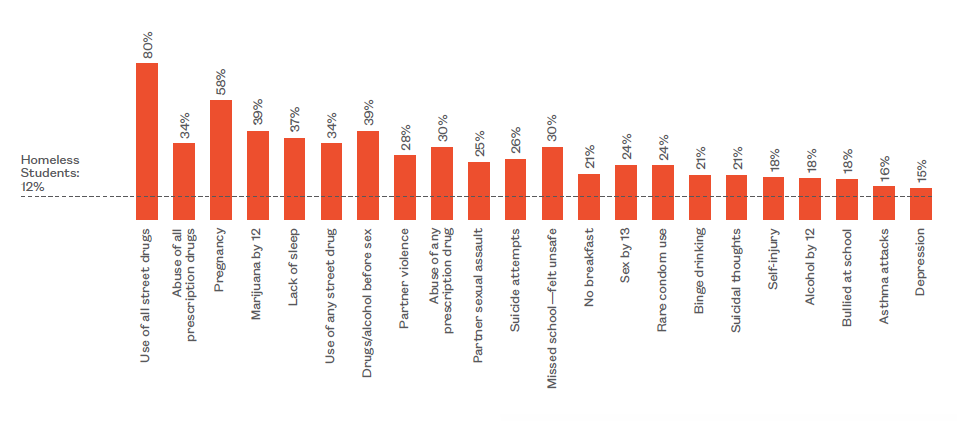
Physical Risks: Dating Violence and Sexual Assault, Risky Sexual Behavior, and Alcohol and Drug Use
Homeless high school students face challenges beyond a place to sleep. They are more likely than other teens to find themselves in situations that endanger their health and physical safety—including violent and sexually exploitative relationships.
Homeless teens experience three times the rate of sexual and physical violence in their dating relationships when compared to teens who are not homeless, and they were more likely to be exposed to environments that promote high-risk sexual, alcohol, and drug use behaviors.
These experiences as a teen can have long-lasting negative impacts on health and well-being into adulthood, and can be a detriment to high school graduation, post-secondary enrollment, and professional pursuits. Sexual and physical relationship violence as a teen increase the risks of depression, anxiety, and post-traumatic stress disorder (PTSD). They can also increase the likelihood of experiencing ongoing intimate partner violence as an adult, as well as becoming the victim of sex trafficking.1 Unprotected sex and sex while under the influence of alcohol and drugs have been shown to increase chances of teen pregnancy, as well as contracting HIV and other sexually transmitted infections (STIs).2 Alcohol and drug use as a teen is known to cause memory lapses, liver damage, and lasting problems with addiction.3
While the health impacts of substance abuse can be considerable, some of the most damaging consequences of alcohol and drug use for teens are the associated risky social behaviors. Teens who abuse alcohol and drugs are more likely to have criminal records that cannot be expunged, be involved in accidents and assaults, damage relationships with their social support network, and forego academic opportunities.4 Not addressing the realities faced by homeless high school students can lead to irreversible health and social consequences.
1 Centers for Disease Control and Prevention, “Teen Dating Violence,” www.cdc.gov, accessed January 4, 2017.
2 Centers for Disease Control and Prevention, “Sexual Risk Behaviors: HIV, STD, & Teen Pregnancy Prevention,” www.cdc.gov, accessed January 4, 2017.
3 National Institute on Drug Abuse, Drugs, Brains, and Behavior: The Science of Addiction, revised July 2014.
4 Tanya Dickinson and Ann Crowe, “Capacity Building for Juvenile Substance Abuse Treatment,” Juvenile Justice Bulletin, December 1997.
xxxx
Dating Violence and Sexual Assault
“The streets, it’s always there for you. Like someone on my block might say ‘Hey, you all right? You can come stay with me,’ and they’re a drug dealer, and it’s not like necessarily we’re doing anything bad, but it’s just the environment I’m around. So what happens after that? You know what I mean? It’s not good.”
—Graduate, Class of 2013
Homeless high school students suffer abuse at the hands of intimate partners.
-
Homeless high school students were three times more likely to report having been deliberately hurt by someone they were dating than their housed peers (27% to 9%).
-
Nearly one-quarter of homeless high school students said that they had been forced to do something sexual that they did not want by someone they were dating in the last year. This was more than twice as high as the rate for housed students (23% to 9%).
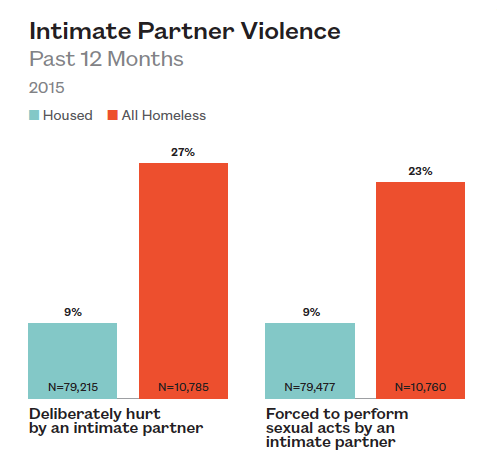
Risky Sexual Behavior
“Despite everything that I was going through, the many distractions and the negative things coming my way—people wanting me to prostitute—I would say no. … I told myself that my only way out of this predicament is through a higher education. School and education was my outlet.”
—Graduate, Class of 2010
Homeless high school students are engaging in sexual activities that endanger their health.
-
Homeless teens become sexually active at a much younger age than their housed peers—20% start having sex before they turn 13. This is over three times the rate of housed teens (6%).
-
Nearly 40% of homeless high school students have sex while under the influence of alcohol or drugs, a rate over three times higher than housed students (38% to 12%).
-
More than a third (36%) of homeless teens rarely or never use a condom during sex, compared to 26% of housed teens.
-
Homeless high school students are at a much greater risk of pregnancy than their housed peers. In the past 12 months, about one in ten homeless students got pregnant or got someone pregnant, compared to only one in 100 housed students (10% to 1%).
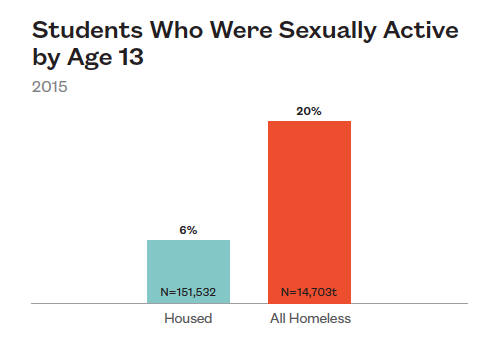
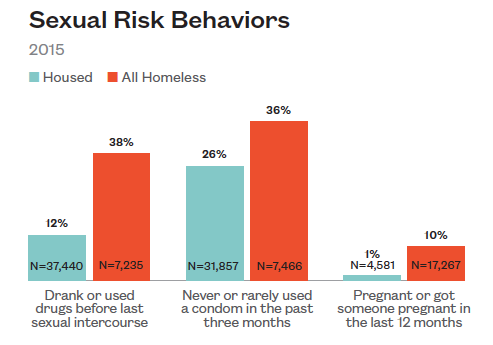
Alcohol and Drug Use
“It was just so much, I wanted an outlet, so I started to write—I write poetry. But when that wasn’t doing a lot for me, I found myself starting; using marijuana a lot. Talking about smoking seven blunts in one hour. I just didn’t want to be conscious to society, to the world.”
—Graduate, Class of 2010
Homeless high school students are at risk for substance abuse.
-
Nearly 30% of homeless high school students first tried alcohol before the age of 12—in elementary or middle school—almost twice the rate of their housed peers (29% to 16%, respectively).
-
Not only are homeless students more likely than their housed peers to try alcohol at a younger age, they also are more likely to engage in dangerous drinking behavior—17% of homeless students binge drink compared to just 7% of housed teens. Homeless teens also binge drink more frequently than housed high school students.
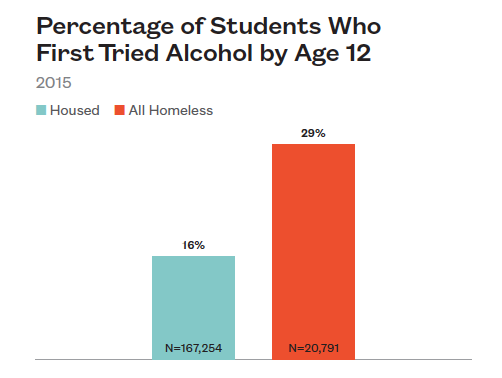
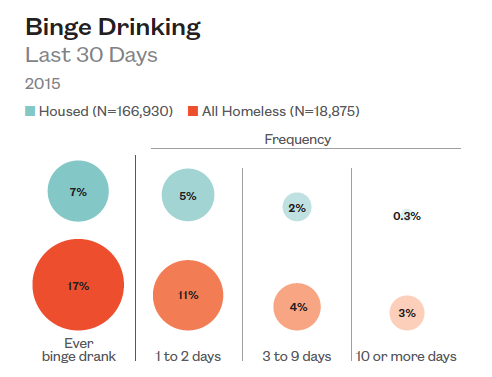
-
Homeless students try marijuana for the first time at a younger age than their housed peers. About one in five tried marijuana before the age of 12 compared to just 4% of housed students.
-
One quarter of homeless high school students have used a hard street drug such as cocaine, heroine, ecstasy or synthetic marijuana compared to only 6% of their housed peers.
-
Nearly a quarter of homeless teens use prescription pain medication, benzodiazepines, and/or stimulants without a doctor’s prescription compared to just 7% of their housed peers.
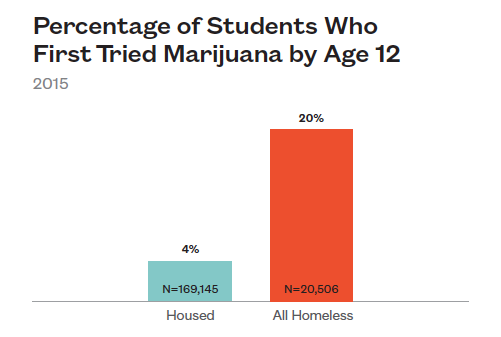
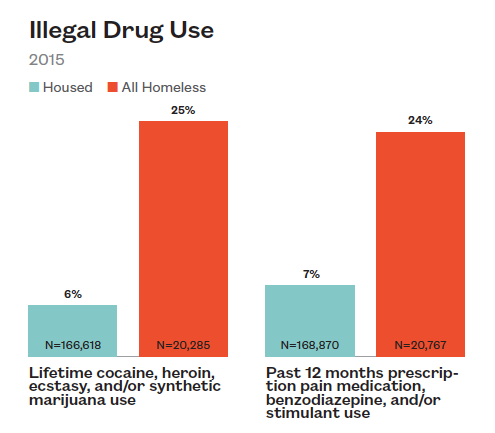
xxx
Unmet Social and Emotional Needs: Depression, Self-Harm, and Suicide
Physical and sexual violence, substance abuse, and the day-to-day stress of homelessness take a toll on homeless high school students’ mental health. As a result, homeless teens faced higher rates of depression and were over three times more likely to attempt suicide than their housed peers.
Mental health struggles are a widely recognized outcome for people who have experienced trauma, but homeless students are often unable to access the social and emotional supports that they need. Recognizing these challenges and the impact of trauma on homeless students’ lives and mental well-being highlights the need for increasing access to trauma-informed services for teens in New York City schools.
Depression
“My dad is in prison now for stabbing my mother in the stomach. I saw everything and had nightmares for a long time. I still don’t understand exactly why it happened.”
—Student, Class of 2021
Homeless high school students are struggling with depression.
-
During the past 12 months, 43% of homeless teens struggled with depression compared to 28% of their housed peers.
-
Depression rates are most severe for unaccompanied homeless high school students—close to half felt so sad or hopeless that they stopped participating in some of their usual activities.
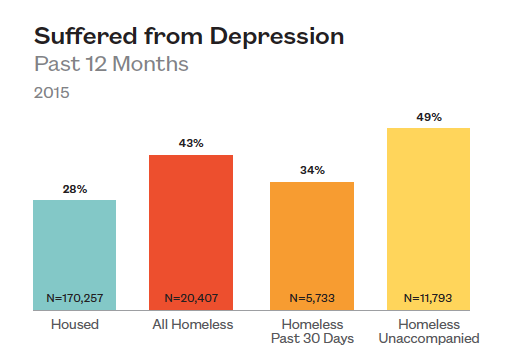
Self-Harm
Homeless high school students are physically hurting themselves.
-
Nearly a quarter of homeless high school students deliberately hurt themselves, two times more than housed students (23% to 12%).
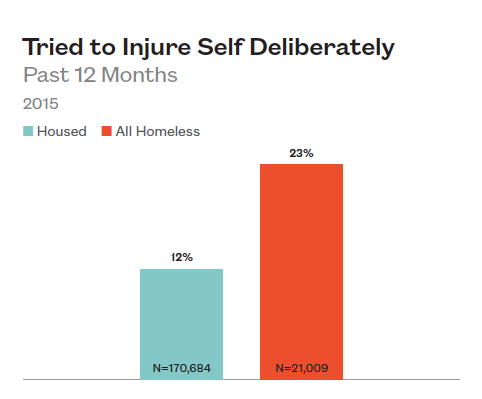
Suicide
“From depression to self-esteem, from wanting and attempting suicide to abuse of drugs and alcohol to risky sexual behavior—I’ve pretty much gone through it or experienced it just to survive.”
—Graduate, Class of 2010
Homeless high school students think about ending their life.
-
Overall, a quarter of homeless high school students have considered suicide, more than twice the rate of their housed peers (27% to 12%).
-
Not only do homeless high school students consider suicide more often than their housed peers, but they are also more than three times more likely to have attempted suicide in the last year (19% to 6%).
-
Homeless teens attempt suicide more often than their housed peers and their attempts are more serious. Nearly half of all homeless students who attempt suicide require medical attention compared to about a third of housed teens (46% to 31%).
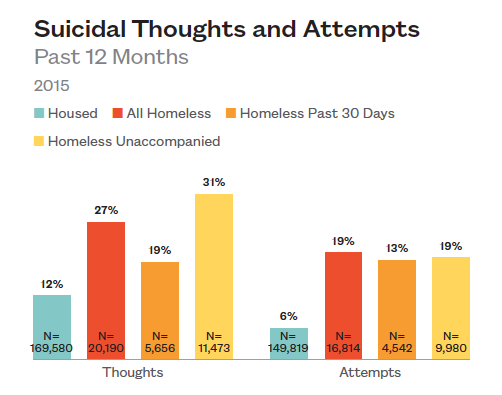
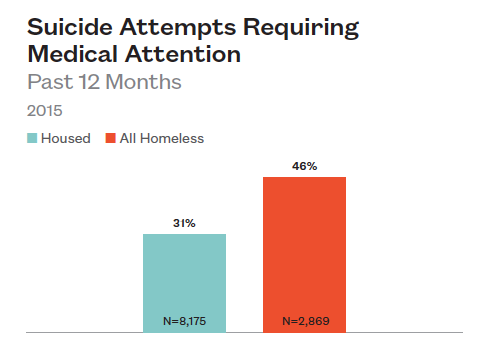
Lack of Basic Necessities: Food Insecurity and Insufficient Sleep
Homeless high school students not only contend with physical and sexual violence, struggle with substance abuse, and battle depression, but their unmet needs include the very basic fundamentals of health.
Adequate nutrition and sleep are essential to the well-being and academic success of adolescents. However, many basic necessities are out of reach for homeless teens who are more than twice as likely to go to school hungry than their housed peers and nearly five times as likely to get fewer than four hours of sleep.
Food insecurity and lack of sleep are known to contribute to a variety of negative health outcomes including increased risk of illness, chronic stress, and a greater risk of obesity and diabetes. In addition to impacting the health of homeless students, the lack of food and sleep can also get in the way of their education. Difficulty concentrating, chronic fatigue, and the need to focus on basic survival can lead to frequent school absences and increase the risk of dropping out.1, 2
1 J. S. Lee, C. Gundersen, J. Cook, B. Laraia, and M. A. Johnson, “Food Insecurity and Health Across the Lifespan,” Advances in Nutrition: An International Review Journal, 3, no. 5 (September 1, 2012): 744–45.
2 Joseph A. Buckhalt and Mona El-Sheikh, “Sleep and Poverty,” The SES Indicator, 6, no. 4 (November 2013): online.
Food Insecurity
“I remember going to M&M World, stealing the candy and putting it in my pocket, being chased by the security guard. But I was doing it because I was hungry. … Imagine going the whole day not eating.”
—Graduate, Class of 2010
Homeless high school students go to school hungry.
-
Homeless high school students are more than twice as likely than their housed peers to go to school hungry. In the past seven days, 32% of homeless students did not have breakfast compared to just 14% of housed students.
-
Additionally, unaccompanied homeless high school students are the most food insecure: 41% did not ever have breakfast in the last week.
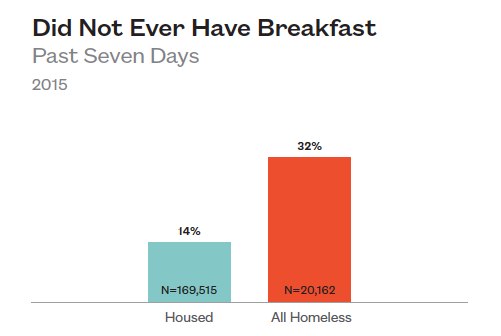
Insufficient Sleep
Homeless high school students do not get enough sleep.
-
Homeless high school students were much less likely than their housed peers to get a healthy amount of sleep. Only 24% of homeless adolescents sleep seven or more hours per night compared to 55% of housed students.
-
Even more striking, 42% of homeless high school students sleep four or fewer hours per night. This is the case for only 9% of housed students.
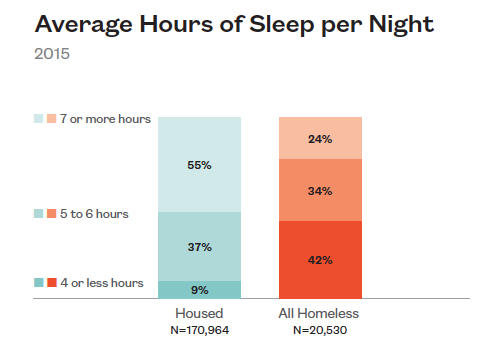
No Safe Space: Bullying and School Safety
Access to sufficient food and sleep are not the only unmet health needs of homeless high school students. School environments where students feel safe, both emotionally and physically, are also critical to learning, emotional development, and overall well-being.
Homeless teens, however, were two times more likely to report being bullied at school and three times more likely to miss school due to feeling unsafe.
Bullying and violence at school put students at greater risk of anxiety, depression, self-harm, and suicide. They have also been linked to increased absences and negative educational outcomes and are increasingly the focus of national school-wide interventions.1 Meeting the unique safety needs of homeless high school students as a part of these interventions is critical.
1 U.S. Department of Health and Human Services, “Effects of Bullying,” http://stopbullying.gov, accessed January 4, 2017.
Bullying
“I don’t know what they saw, but people would always find a reason to pick on me, but to me, like that was just the norm. I’m like, life is already bad, so what was the worst that can happen? So I just accepted it as the norm.”
—Graduate, Class of 2010
Homeless high school students are bullied.
-
About a quarter of homeless high school students are bullied, nearly twice the rate of housed students (24% to 13%).
-
Additionally, unaccompanied homeless high school students see the highest rates of school bullying at 28%.
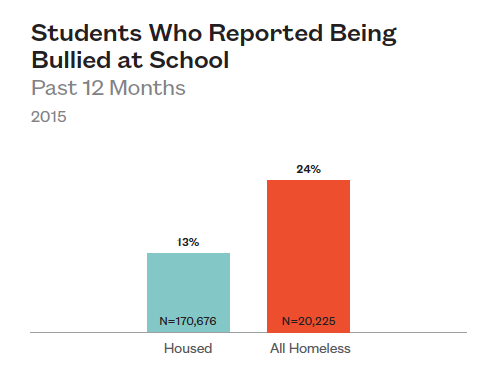
School Safety
Homeless high school students do not feel safe in school.
-
Homeless high school students miss school more often because they do not feel safe. About 13% of homeless students missed school in the past 30 days because they felt unsafe compared to just 4% of housed students.
-
Homeless high school students also miss more total school days due to safety concerns. Over 6% of homeless students missed four or more days of school in the past 30 days due to safety concerns compared to less than 1% of housed students.
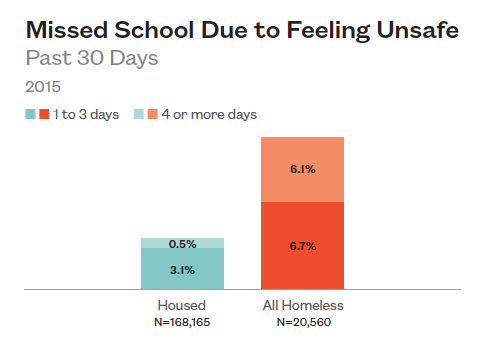
Missed Opportunities for Medical Care: School-Based Health Centers and Uncontrolled Asthma
For homeless and other underserved students, school-based health centers often provide a medical home within the only safe and stable place many of these students know—their school.
Unsurprisingly, homeless high school students are much more likely than housed teens to lack access to medical care. Homeless children are, like all children, vulnerable to the flu, HPV, sinus infections, obesity, and more. The YRBS only asks about asthma specifically, but we can consider this a gateway to a better understanding of the specific medical needs of homeless students.
Uncontrolled asthma rates are significantly higher for homeless students, suggesting that they have insufficient access to preventative medical services and are not being effectively reached by city- and school-wide asthma control programs. Asthma is a leading cause of school absences in New York City; a student who is chronically absent in any grade 8–12 is over 7 times more likely to drop out of high school.1
This is a missed opportunity to meet the medical needs of homeless teens. While homeless high school students have less access to school-based health centers, they are more likely to use them than their housed peers when they are available.
1 Utah Education Policy Center at the University of Utah. Chronic absence in Utah public schools, 2012.
Asthma Attacks
Homeless high school students are not receiving appropriate preventive care.
-
Among high school students with asthma, homeless teens are more likely to have had an asthma attack in the past twelve months. A third of homeless students with asthma have had an attack compared to 20% of their housed peers.
-
High school students who were homeless in the past 30 days had the highest rate of uncontrolled asthma—over two times higher than that of their housed peers (44% to 20%).
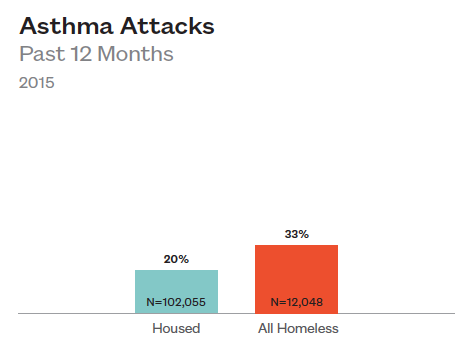
School-Based Health Centers
“I missed school a lot because my stomach was always hurting. The hardest part was that nobody believed I was sick. Everybody just thought I was skipping school. Later I was diagnosed with Lupus and IBS. It took a really long time to be diagnosed. We were moving around. I kept going to the emergency room.”
—Graduate, Class of 2016
Homeless high school students need access to medical services.
-
Homeless high school students are less likely to have access to a school-based health center than their housed peers (60% to 83% respectively).
-
Only 60% of homeless students have access to a center, yet among those who do, 48% use these facilities compared to 33% of housed students. Lack of access to school-based health centers represents a missed opportunity to connect homeless students to medical care.
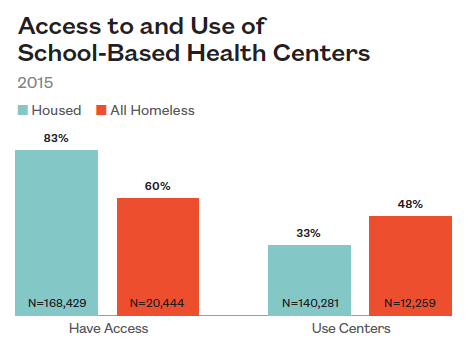
“The school is not set up to prepare you for the real world. … What about those young people in the room who are struggling from homelessness and insecurity who don’t have time for standardized tests? They want to learn how to survive—school didn’t give me that. So if it wasn’t for a program like S.I.M.B.A. [Department of Education homelessness support program], I probably would have succeeded committing suicide.1”
—Graduate, Class of 2010
1. S.I.M.B.A. (Safe in My Brother’s Arms) Academy Youth Empowerment Program is an out-of-school time program facilitated by Community Counseling and Mediation (CCM), that aims to enrich the lives of high school students in temporary housing by providing support services and an environment that encourages youth to achieve.
Policy Considerations
While the YRBS data represent only a small sample of high school students in New York City, the stark differences between homeless teens and their housed peers are cause for alarm. The long-term health and well-being of students experiencing homelessness are in danger, yet until now the unique needs and risks these students face have gone unrecognized. The disparity in health outcomes for homeless students, like the disparity in educational success, appear to surpass the impacts of poverty or race; ameliorating these disproportionate burdens is imperative to breaking the cycle of homelessness.
Leverage Existing Programs
Crucially, programs that address student health needs have been shown to raise academic achievement while simultaneously strengthening public health. Tailoring health education and outreach programs through the New York City Department of Health and Mental Hygiene (DOHMH), expanding school-based health centers, and providing teen health services in shelters all represent opportunities to be explored.1
Link Health Records to School Data
Enacting successful policies and designing programs that will improve the health of New York City students experiencing homelessness will also require more information. There is no reason to believe that the health risks associated with homelessness are isolated to the high school years, yet no information is currently available on the health of homeless children younger than high school. Filling these information gaps is critical; these important data could be gathered by the City. For students younger than high school, school health records could be linked to housing status data collected by the New York City Department of Education (DOE) in order to identify the unique health challenges homeless students face.
Keep Health Outcomes Part of the Narrative
As New York City works to improve the lives of homeless students, those efforts must incorporate an understanding of risk behaviors and health outcomes, which have been shown to predict well-being and productivity later in life.
1 School-based health centers (SBHCs) are managed by the Office of School Health (OSH), a collaboration between the City DOE and DOHMH. There are currently 145 SBHCs serving over 345 schools in New York City’s five boroughs. New York City Department of Education, “school-based health centers,” http://schools.nyc.gov, accessed January 4, 2017.
Appendix
Publication Quotes
The quotes used in this publication came from conversations with current and former NYC public high school students. All students/alumni quoted experienced homelessness with their families.
Youth Risk Behavior Survey (YRBS)
The Centers for Disease Control (CDC) provided access to anonymous self-reported survey data for the sample of high school students in New York City who participated in the Youth Risk Behavior Survey (YRBS) in 2015. The YRBS is a national survey conducted every other year by the CDC. It was developed in 1990 to monitor priority health risk behaviors that contribute markedly to the leading causes of death, disability, and social problems among youth and adults in the United States.1 Questions focus on: behaviors that contribute to unintentional injuries and violence; sexual behaviors related to unintended pregnancy and sexually transmitted infections, including HIV; alcohol and other drug use; tobacco use; unhealthy dietary behaviors; inadequate physical activity; and the prevalence of obesity, asthma, and other priority health-related behaviors. For the first time in 2015, the NYC YRBS also included two questions relating to the experience of homelessness. These questions were: “During the past 30 days, where did you usually sleep?” and “During the past 12 months, did you ever live away from your parents or guardians because you were kicked out, ran away, or were abandoned?”2 Students who responded with anything other than “In my parent’s or guardian’s home” to the first question were labeled as “homeless past 30 days” and students who responded “yes” to the second question were labeled as “homeless unaccompanied.”
Student Weighted Sample
The sample consisted of 275,537 students, 193,574 of whom responded to both housing questions. Of those students, 172,244 were housed, 6,021 reported that they had been homeless in the past 30 days, 12,138 students said they were homeless unaccompanied, and 3,171 responded that they had been both homeless in the past 30 days and homeless unaccompanied in the last year. Combined, a total of 21,329 students, or 11% of the sample, reported experiencing either or both forms of homelessness.3 These 21,329 students are categorized as “all homeless” and referred to simply as “homeless” in the text. Sample sizes are included in all figures but vary by question due to non-response. Only students who answered both housing questions were included in the analysis. Data are weighted to represent the total population of high school students in New York City. They are estimates and reflect differences in the experiences of students surveyed by whether they were housed of homeless.
Housed and homeless students in the sample had both similarities and differences demographically. Nearly 30% of both groups were black and just under 15% were white; however, a smaller proportion of homeless students identified as Asian (10% homeless and 22% housed). A slightly larger percentage of homeless students identified as Hispanic or Latino, including multiracial, (45% compared to 34%), and students reporting homelessness were more likely to be male (56% compared to 47% housed). More homeless students than housed identified as LGBTQ, but the majority of both homeless and housed students identified as heterosexual (81% and 85%, respectively).4
xxx
Glossary of Terms
Binge Drinking
Drinking in excess in a short period of time, often characterized as having at least four (for women) or five (for men) drinks within two hours; defined by answering YRBS Question 44: During the past 30 days, on how many days did you have 5 or more drinks of alcohol in a row, that is, within a couple of hours?
Deliberately Hurt
Purposely physically hurt by a partner; defined by answering YRBS Question 22: During the past 12 months, how many times did someone you were dating or going out with physically hurt you on purpose?
Depression
Perpetual sadness and disinterest; defined by answering YRBS Question 26: During the past 12 months, did you ever feel so sad or hopeless almost every day for two weeks or more in a row that you stopped doing some usual activities?
Homeless
Experienced either or both of the following types of homelessness (subcategories are mutually exclusive):
Homeless in the Past 30 Days
Usually slept somewhere other than at home with parents or guardians during the past 30 days; defined by answering YRBS Question 121: During the past 30 days, where did you usually sleep?
Unaccompanied
Lived away from home due to being kicked out, running away, or being abandoned during the past 12 months; defined by answering YRBS Question 122: During the past 12 months, did you ever live away from your parents or guardians because you were kicked out, ran away, or were abandoned?
Housed
Usually slept at home with parents or guardians during the past 30 days, did not live away from home due to being kicked out, running away, or being abandoned during the past 12 months.
Sample
A portion of the population that should not necessarily be generalized to the entire population.
School-Based Health Centers
School-based health centers (SBHC) are health facilities located in schools that provide both primary and preventive health care. These centers can serve as a student’s primary point of care or complement services from an outside primary care provider. SBHCs in New York City provide both scheduled and walk-in services when schools are in session and 24-hour telephone coverage when the SBHC is closed.5
Self-Harm
Hurting oneself on purpose without the intention of suicide; defined by answering YRBS Question 94: During the past 12 months, how many times did you do something to purposely hurt yourself without wanting to die, such as cutting or burning yourself on purpose?
Sexually Active
Ever had sexual intercourse; defined by answering YRBS Question 61: How old were you when you had sexual intercourse for the first time?
Suicidal Thoughts
Thinking about killing oneself, but not necessarily attempting to do so; defined by answering YRBS Question 27: During the past 12 months, did you ever seriously consider attempting suicide?
Survey
Collecting data by asking questions. Surveys are typically only administered to a sample of the population and should not necessarily be generalized to the entire population.
Unweighted Sample
Keeping all responses equal, even though some groups may be unequally represented. Data presented in this report are weighted.
Weighted Sample
Making some responses count more than others in an attempt to replicate the distribution of the population, which may have been uneven in the sample.
Youth Risk Behavior Survey (YRBS)
A national survey conducted every other year by the Centers for Disease Control (CDC) to monitor priority health risk behaviors that contribute markedly to the leading causes of death, disability, and social problems among youth and adults in the United States.6
1 Centers for Disease Control and Prevention, “Youth Risk Behavior Surveillance System (YRBSS) Overview,” www.cdc.gov, accessed January 4, 2017.
2 Centers for Disease Control and Prevention, 2015 New York City Youth Risk Behavior Survey.
3 Ibid.
4 Centers for Disease Control and Prevention, 2015 New York City Youth Risk Behavior Survey.
5 New York City Department of Education, “School Based Health Centers: Services,” http://schools.nyc.gov/Offices/Health/SBHC/SBHC.htm (accessed January 12, 2017).
6 Centers for Disease Control and Prevention, “Youth Risk Behavior Surveillance System (YRBSS) Overview,” www.cdc.gov, accessed January 4, 2017.
Survey Questions
The health outcomes in this publication were based on YRBS questions that had responses from both homeless and housed students.
Question 16: During the past 30 days, on how many days did you not go to school because you felt you would be unsafe at school or on your way to or from school?
Question 22: During the past 12 months, how many times did someone you were dating or going out with physically hurt you on purpose?
Question 23: During the past 12 months, how many times did someone you were dating or going out with force you to do sexual things that you did not want to do?
Question 24: During the past 12 months, have you ever been bullied at school?
Question 26: During the past 12 months, did you ever feel so sad or hopeless almost every day for two weeks or more in a row that you stopped doing some usual activities?
Question 27: During the past 12 months, did you ever seriously consider attempting suicide?
Question 29: During the past 12 months, how many times did you actually attempt suicide?
Question 30: If you attempted suicide during the past 12 months, did any attempt result in an injury, poisoning, or overdose that had to be treated by a doctor or nurse?
Question 42: How old were you when you had your first drink of alcohol other than a few sips?
Question 44: During the past 30 days, on how many days did you have 5 or more drinks of alcohol in a row, that is, within a couple of hours?
Question 48: How old were you when you tried marijuana for the first time?
Question 50: During your life, how many times have you used any form of cocaine, including powder, crack, or freebase?
Question 52: During your life, how many times have you used heroin (also called smack, junk, or China White)?
Question 55: During your life, how many times have you used synthetic marijuana (also called K2, Spice, fake weed, King Kong, Yucatan Fire, Skunk, or Moon Rocks)?
Question 61: How old were you when you had sexual intercourse for the first time?
Question 64: Did you drink or use drugs before you had sexual intercourse the last time?
Question 79: During the past 7 days, on how many days did you eat breakfast?
Question 88: On an average school night, how many hours of sleep do you get?
Question 94: During the past 12 months, how many times did you do something to purposely hurt yourself without wanting to die, such as cutting or burning yourself on purpose?
Question 100: During your life, how many times have you used ecstasy (also called MDMA, “Molly,” “E,” or “X”)?
Question 101: During the past 12 months, how many times have you taken a prescription pain medication, such as Oxycontin, Percocet, Vicodin, Hydrocodone, or Oxycodone without a doctor’s prescription?
Question 102: During the past 12 months, how many times have you taken benzodiazepines such as Xanax, Valium, Klonopin, or Ativan, without a doctor’s prescription?
Question 103: During the past 12 months, how many times have you taken stimulants such as Adderall, Ritalin, Concerta, or Vyanese, without a doctor’s prescription?
Question 104: During the past 3 months, how often did you or your partner use a condom when you had sexual intercourse?
Question 108: During the past 12 months, have you been pregnant or gotten someone pregnant?
Question 120: During the past 12 months, have you had an episode of asthma or an asthma attack?
Question 124: Have you ever used the school-based health center (school clinic) at your school?
